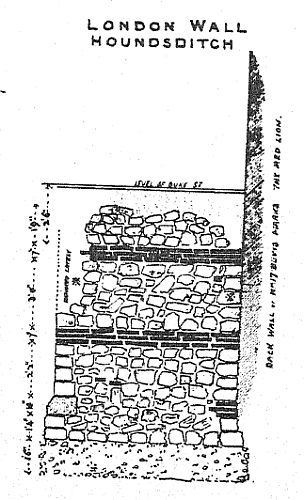

Search london history from Roman times to modern day
December 8, 2020 London history, walk the London Wall part 1b
Walk the next part of the Roman London wall 4
Bevis Marks, East end. The south-eastern extension called of Bevis Marks is called Dukes place, and was originally called Duke street. In 1880 a stretch of about 70 feet of the wall was exposed and removed in the rebuilding at the back of No. 31 Houndsditch. This address was the Red Lion, at 17 Bevis Marks, latterly at 31 Houndsditch as the entry altered. It is latterly called the White Horse but is now closed. The address of 17 Bevis Marks is at or near the Creechurch lane, and is still recognisable today. Bevis Marks House was at 24 Bevs Marks, and is still at this address today.
The NLS maps show clearly the line of the old London wall alogside a more modern ordnance survey mapping.
The NLS maps show clearly the line of the old London wall alogside a more modern ordnance survey mapping.
Red Lion, 17 Bevis Marks, All Hallows London Wall, City of London EC3 – in 1948

Back wall at No 17 Bevis Marks
Back wall at No 17 Bevis Marks Further along Bevis Marks, but still east of Goring street was another section of the original London wall. In 1923 a stretch of the wall about 120 feet long and 8 1/2 feet thick immediately South East of Goring Street was uncovered and destroyed. And again another section west of Goring street (formerly called Castle street) was sketched in 1884 by a H Hodge. I will add some modern images to this section as I find them. The Wall then crosses St Mary Axe, and extends along Camomile street. In 1905 a stretch of the wall was uncovered at the back of Nos. 58 and 60 Houndsditch and also adjoining the churchyard belonging to the parish of St. Martin Outwich. In 1926 a further portion of this same section of the wall was revealed and destroyed. In 1876 a stretch of the wall 70 feet long was uncovered in the middle section of Camomile street. It was 8 feet thick and was destroyed above the plinth [J. E. Price, On a Bastion of London Wall, 1880].
Section of Bastion and Wall Camomile street 1876
The London Wall is next along the appropriately named London Wall – hooray. And Last updated on: Monday, 07-Apr-2025 11:55:27 BSTTrying to avoid privacy and cookie settings overwriting content